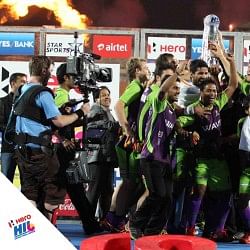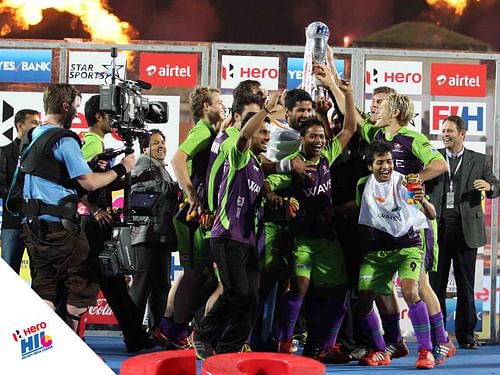
Hockey India League 2014 - Thoroughly competitive event a good sign for Indian hockey

The 2014 Hockey India League champions Delhi Waveriders
The just-concluded Hockey India League 2014 finished much closer than expected. The last two games on the final day were decided by penalty shootouts. A penalty shootout is always a harsh way of deciding the winner; it comes down to a contest between a player and a goalkeeper. Yet one must agree that ultimately, the optimal result came about in this year’s HIL.
In soccer, Germans rarely lose a penalty shoot-out, and Nicolas Jacobi proved that the same applies in hockey too. He admitted in the post-match reaction that he had never lost a shoot-out in his career. That is why he was confident of winning it for his team.
Jaypee Punjab Warriors played like champions throughout the tournament, except in the final. They lost only two of their matches – the first and the last. Unfortunately, on both the occasions, it was the Delhi Waveriders who sunk them. Statistically, they scored the most number of goals, showed the best penalty corner conversion rate and topped the table in the league stage. But they missed a lot of chances in the final, specially in the final quarter of the game. They will rue that for a long time to come.
All the teams relied heavily on penalty corners for scoring, which can be seen in the final tally of goal-scorers as well. Four Indians were in the fray for the top spot. V R Raghunath (Punjab) and Rupinder Pal Singh (Delhi) put up a satisfactory show. Raghunath scored the only hat-trick of the tournament against Mumbai Magicians.
Gurjinder Singh was a flop for Mumbai Magicians. He scored on only two occasions which cost his team heavily. An example can be supplied here. He took the penalty corner against Ranchi Rhinos in the dying seconds. He could have been the hero had he converted that PC. Instead, he shot the ball straight to the keeper.
Argentina, meanwhile, can hope to regain their glory days from the past with the help of Gonzalo Peillat. He is young and physically very strong. Among drag flickers, he was the only one who scored goals in all the corners of the post.
But Sandeep Singh emerged as the leader of the pack. With his 11 goals, 10 of which were through penalty corners, he again became the highest goal-scorer of the tournament. His conversion rate was 40%. Proper injection by Dharamveer and accurate stopping by Hammond helped him in accumulating that goal tally.
Sandeep was shown the door from the national team due to his weakness in defence. In this tournament however, he showed no signs of that problem. He also played with an attacking mentality and provided crucial goal-bound passes to the strikers. His recall for national duties is only a matter of time.
Akashdeep Singh won the ‘Best Young Player’ award, and he thoroughly deserved it. He scored three goals (one fewer than compatriots Nikkin Thimmaiah and Yuvraj Walmiki). The reason the award went in his favour was his strong play in creating opportunities for goal. He impressed with his skills and runs. His solo run from the half line in the final which ended in a pin-point goal bound pass to Lloyd Norris-Jones was his finest moment. Akashdeep had a lukewarm Junior World Cup, but now he can surely be said to be a star in the making.
Ramandeep Singh probably played the worst tournament of his career. He was the costliest Indian player, having been purchased by U P Wizards for US$81,000. But he didn’t live up to the expectations, as his injuries reduced his strengths. In the matches that he did play, he failed to create a deep impression on the minds of UPW fans. His position in the senior squad is in real danger.
Tushar Khandekar and Shivendra Singh, who were regulars in the national team up to the London 2012 Olympics, displayed good hockey. They have now submitted fresh claims for entry into the Indian team. Manpreet, Kothajit, Affan Yousuf, Satbir, Danish Mujtaba and Yuvraj Walmiki all proved their worth among the Indian players. Ashley Jackson, Simon Orchard, Jamie Dwyer, Teun de Nooijier, David Alegre and Glenn Turner played to their reputation among the foreigners.
Jaap Stockmann and Nicolas Jacobi were the best men under the bar. All the teams relied heavily on foreign goalkeepers. Only Harjot Singh of Kalinga Lancers spent a decent amount of time on the turf among the Indian goalkeepers. Harjot showed signs of callowness in the beginning but matured with passing time.
Cedric D’souza stood tall among the multitude of foreign coaches.
Kalinga Lancers started with a 5-0 crushing but later emerged as the most improved side. They won a lot of hearts with their attacking style of hockey. They could hold their heads high even after the losses, particularly in their match against UPW. They lost that game by 4-3 but created 10 shots as compared to four by the winners.
The Mumbai Magicians won two matches but that was too little too late.
The tournament presented several moments to remember. Lalit Upadhyay’s second goal against UPW was a jam. He was surrounded by five defenders but he scored with a beautiful reverse hit. P T Rao’s reflex save against UPW to deny a reverse stick shot was sublime. Nicolas Jacobi’s saves against Ranchi in the league match will be remembered for a long time.
The HIL marked a significant presence of Australians this year. 24 of them played in the league for different clubs. Eight Aussies were part of the Punjab squad.
The next year’s edition promises to provide even more fun and entertainment. Many players eschewed the HIL this year due to World Cup preparations. Surely, talents from Belgium and other nations (who knows, maybe even from Pakistan) will grace the event in 2015.
All of this is a good sign for the future of Indian hockey. This year’s edition was very competitive, and if the patten continues in the coming years, it will surely benefit Indian hockey greatly.